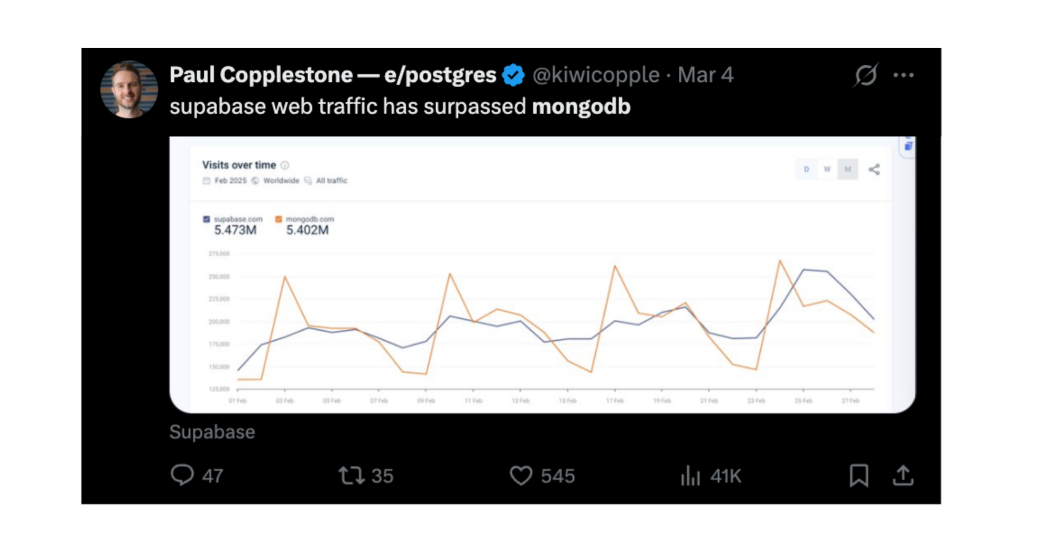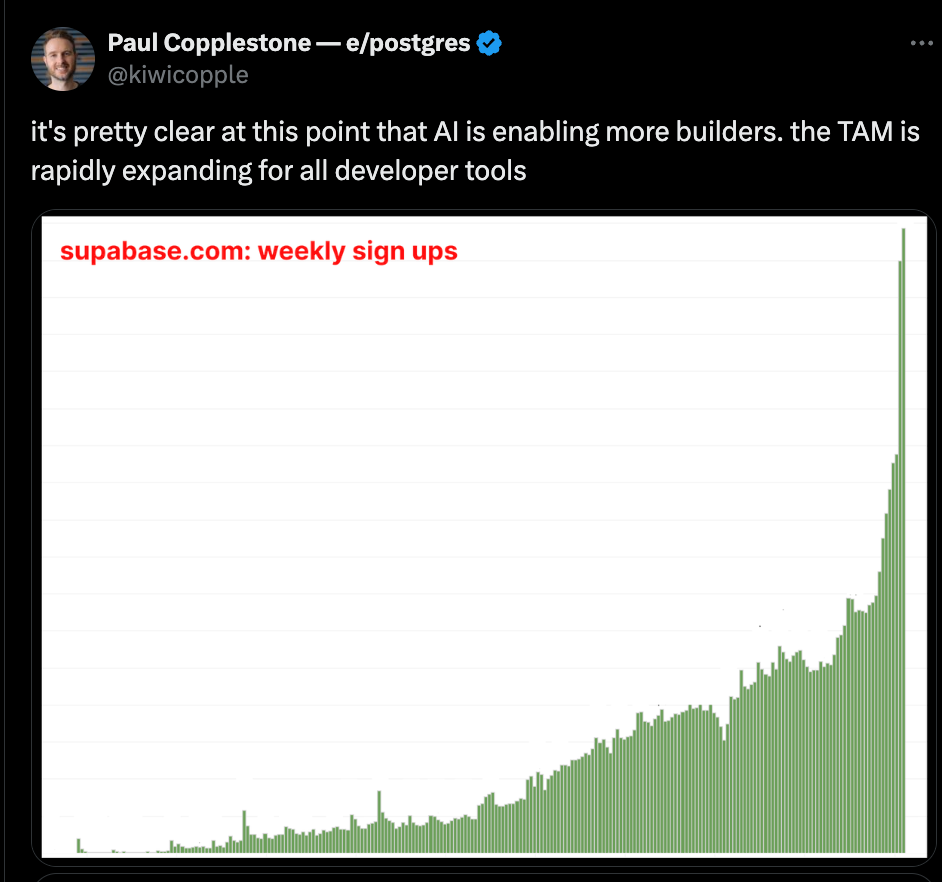How Supabase Made PostgreSQL Cool Again
 swyx
swyx
Intro: Hey Thor! What are the most common/major misconceptions about Supabase?
One of the biggest misconceptions is that Supabase is "just a Firebase alternative." While that framing helped early on to convey quickly what Supabase is, it doesn't fully capture what Supabase has become. Firebase is an awesome product with a great DX, but it's a different paradigm—NoSQL, proprietary, and tightly coupled with Google Cloud.
Supabase is fundamentally Postgres-first. It's not just a database; it's a database with batteries included—giving you authentication, APIs, storage, realtime, and even vector db features while keeping the flexibility and expandability of Postgres.
Another misconception is that Supabase is only for side projects or early-stage startups. In reality, there are companies running production workloads at serious scale—hundreds of thousands of databases, multi-terabyte datasets, and high-traffic applications. Postgres is battle-tested, and Supabase is making it easier to use without locking you into proprietary tech.
Success Metrics
What are some “real” metrics that you track that point to Supabase’s devrel success?
DevRel can be tricky to measure, as you so well captured in your Measuring Developer Relations piece from 2021, but there are a few things we track to help show our impact:
Database Growth – When I joined, there were around 800 databases. Now there are well over a million (actually more, but that’s the last official number that was published). That’s a direct signal of people actually using the product, not just engaging with content.
Open-Source Contributions – The number of contributors to Supabase repos is a great signal of developer engagement. We have thousands of contributors across different projects, from core database extensions to frontend SDKs.
Community-Sourced Content – Seeing third-party tutorials, YouTube videos, and courses being created without us asking is a strong sign that the product is resonating. If developers are teaching others about Supabase, that’s the highest form of advocacy.
DevRel-Initiated Features – Features like Supabase Vector and Edge Functions came from direct community engagement. DevRel isn’t just about generating awareness and educating developers; it’s about shaping the product based on what developers actually need.
DevRel @ Supabase
What was your reaction to the ZIRP DevRel article? What’s different about how Supabase does DevRel compared to “normal” or “ZIRP” devrel?
The ZIRP DevRel conversation was fascinating. Supabase has always been lean and product-driven. Rather than hiring a large DevRel team, we’ve very early on conveyed the message that everyone at the company is in the DevRel team. If you’re building developer tooling and you’re not having a relationship with the developers you're building for, you’re not going to survive. So rather than hiring tons of DevRel, we focused on supporting everyone in the company to be developer facing.
Developer Community
Supabase maintains a -lot- of open source work, and only (~90?) employees. How does community open source engagement work?
Supabase maintains a ton of open-source projects with a relatively small team (~90 people), so community involvement is critical. There are a few key things that make it work:
Public-First Development – Everything happens in the open. GitHub issues, discussions, and RFCs aren’t hidden away in private Slack channels.
Good First Issues – Actively curating tasks that are approachable for new contributors keeps the momentum going.
Fast Feedback Loops – If someone contributes, we try to review and merge quickly. Nothing kills open-source enthusiasm faster than a PR sitting for months with no response.
It’s not just about getting more contributions, but about making sure contributors feel valued and want to stick around.
Developer Twitter
Supabase is well known for the memes on X/Twitter, so much that there’s even a case study on it! What would you say is the current process that works for engagement? What are the top 2-3 things that you always advise other companies to do/try?
The memes get a lot of attention, but there’s a structured approach behind it:
High Signal-to-Noise Ratio – Every meme, joke, or post should tie back to real developer pain points or features. Otherwise, it’s just noise.
Engagement Over Broadcast – Instead of just posting and leaving, we actively engage—replying to developers, boosting community projects, and joining conversations.
Consistency and Speed – We respond quickly to trends, launch features in a way that’s engaging, and experiment constantly.
Companies often ask how to “do Twitter like Supabase,” but the real answer is: Have a great product first, then make sure your voice reflects how developers actually talk. And actually in most cases and for most companies I wouldn’t recommend trying to replicate the meme game. For Supabase, for some crazy reason it works, because Supabase is kind of like your weird co-worker, who makes strange jokes, but also is super helpful, so you just vibe along.
Launch Weeks
Supabase is also well known for popularizing the Launch Weeks trend, which there have been many good interviews discussing. What do LWs look like specifically from the DevRel perspective? How do you encourage other company DevRels to work with product/eng for launch weeks?
Launch Weeks are a massive coordination effort between DevRel, engineering, and product, but at the same time you need to remember that launch weeks are mainly a marketing/hype tool. Supabase of course ships features constantly, but every ~3-4 months, we identify a bunch of features that we really want to shout about. We generally curate these in a way that we have at least one very technical feature that does well on HackerNews, as well as at least one more visual feature that does well on ProductHunt. Sprinkled in with a bunch of smaller things throughout the week.
This creates this week long takeover effect, making it look like Supabase is just everywhere and shipping tons of things. And all the content being put out during launch weeks has this multiple week long afterburn effect, where we just see new user signups and weekly active users skyrocket, it really is an incredible effect.
In terms of what this looks like, generally, roughly six weeks before LW, everyone gets together to suggest features that would be a fit. From here we work to establish a rough running order. Once settled, rather than DevRel creating all the content, we work with the eng teams to allow them to create their own docs and content in the most efficient manner possible, for example by having guides on how to create and record a good demo. That’s the secret to shipping so many high quality announcements in such a short time, otherwise that wouldn’t be possible with such a lean team.
You can read about this approach in the How we launch blogpost.
The Iceberg
We asked the usual questions around Twitter and Launch Weeks. What else has been super effective at Supabase that maybe people don’t see?
Everyone sees the Twitter engagement and Launch Weeks, but a few under-the-radar things have been incredibly effective:
Deep Technical Content – Some of the most valuable posts aren’t flashy, but they provide serious technical insight (e.g., optimizations for large Postgres databases).
Dev Advocate Pairing with Engineers – Instead of DevRel operating separately, we work inside engineering teams. That means better documentation, better onboarding flows, and more developer-friendly APIs.
Long-Tail Content Wins – A well-written tutorial from a year ago can still drive significant traffic today. Investing in evergreen technical content pays off more than people realize.
Video content: long-form video content on YouTube as well as short-form video content on X and Instagram can be immense drivers of developer awareness. Here consistency is key. If you consistently create useful content for developers you will see the community flourish.
Prioritization
There’s a lot of interesting applications of Supabase and Postgres extensions/features to create content on for DevRel, and only so much time/resources. How do you decide -what- to focus on?
With so many interesting things happening in Postgres and Supabase, it’s easy to get overwhelmed. The main way we decide what to focus on is:
Community Demand – If we see a lot of people asking about something (e.g., pg_vector and AI), that’s a clear signal to dive deeper.
Feature Adoption Gaps – If a new feature isn’t getting as much usage as expected, that’s usually a sign that better education or content is needed.
Strategic Ecosystem Bets – Sometimes we invest in topics that aren’t huge today but will be critical in the future—like edge computing, background jobs, or AI-native databases.
Moving to ElevenLabs
It took some time to get this interview together, so since we’ve initially started this interview, you’ve moved on from Supabase and joined ElevenLabs. Why this move?
Moving on from Supabase was definitely tough, it’s one of the most incredible companies I have ever seen, and I had been there from the start, working with Copple and Ant from a cafe in Singapore during post-COVID times. The sheer dedication to open source and doing the right thing for users, coupled with a “no asshole” culture that is second to none, makes it a very special place. And I’ll definitely stay close, as a member of the SupaSquad and an investor and shareholder, I’m incredibly excited about Supabase’s future.
That being said, after almost five years contributing to Supabase, I found myself itching for a change. I’ve been passionate about digital audio from a young age, producing albums for my band back home in Germany during my highschool and university days, and studying computer science. So when I got introduced to ElevenLabs, one of the hottest European AI startups, again through a former Stripe colleague, I was attracted by the opportunity of working across digital audio, languages, AI, and APIs, basically all the things I love in one amazing package.
Shameless plug from Thor
I organise a developer community retreat called HackerHouse Taiwan where I bring international & local software engineers together to network in Taiwan. You can watch some impressions from the last retreat here and find more details in this blogpost.
I can confirm that touring Taiwan with you is AWESOME. Thanks Thor!
Subscribe to my newsletter
Read articles from swyx directly inside your inbox. Subscribe to the newsletter, and don't miss out.
Written by

swyx
swyx
Writer & Curator, DX.Tips
